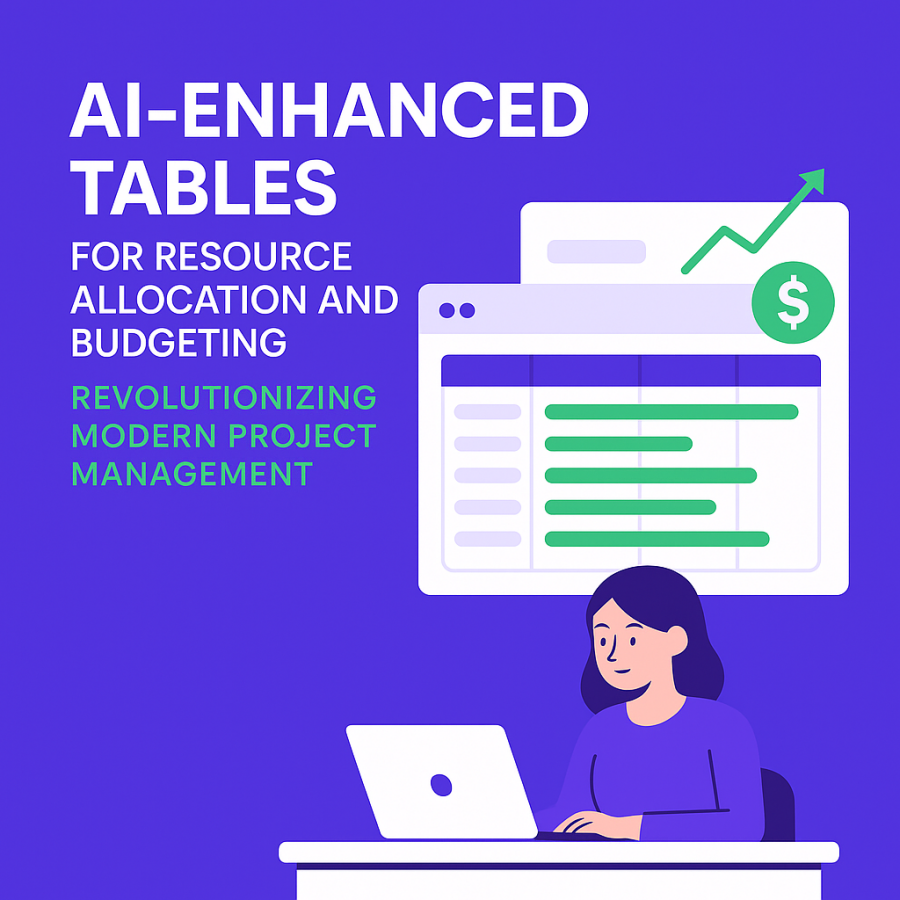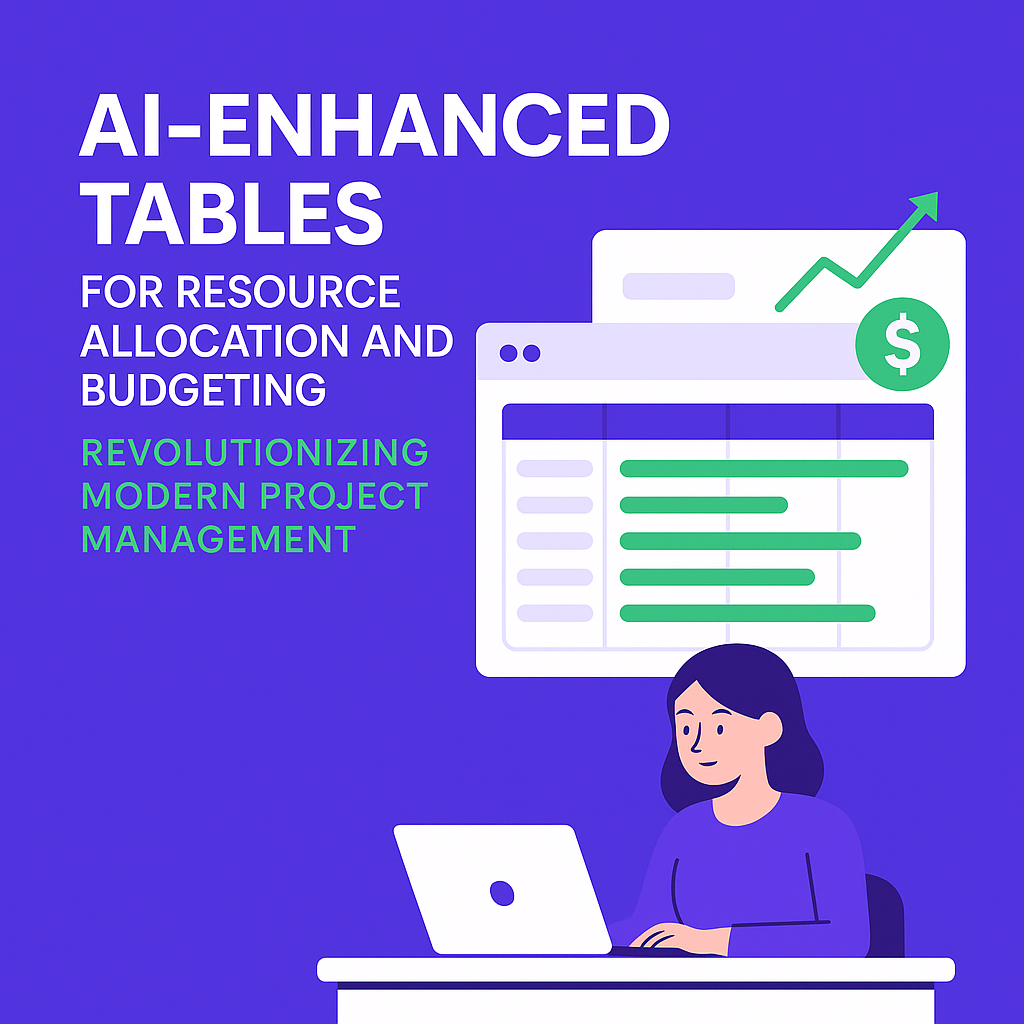Introduction
In today’s rapidly evolving business landscape, project management professionals face unprecedented challenges in optimizing resource allocation and budgeting. Traditional project management tools, often reliant on static spreadsheets and disconnected processes, struggle to keep pace with the complexities of modern projects. The integration of artificial intelligence (AI) into project management software heralds a new era of efficiency, precision, and collaboration.
This article explores the transformative role of AI-enhanced tables in resource allocation and budgeting within the realm of modern project management. It highlights how Artavolo, a cutting-edge AI project planning tool, elevates project execution by combining automation, usability, and real-time insights. Through detailed comparisons, real-world use cases, and an academic perspective, this comprehensive examination provides readers with an in-depth understanding of how AI technologies reshape the future of project management.
1. The Fundamentals of Resource Allocation and Budgeting in Project Management
1.1 Understanding Resource Allocation
Resource allocation involves assigning available resources—such as personnel, equipment, and materials—to project tasks in a manner that maximizes productivity and meets project constraints.
- Human Resources: Skills, availability, and workload distribution
- Material Resources: Consumables and fixed assets
- Financial Resources: Cost caps and funding allocation
1.2 Budgeting in Project Management
Budgeting is the process of forecasting and controlling financial resources to ensure project completion within cost expectations.
- Cost estimation and planning
- Expense tracking and variance analysis
- Allocation of contingency funds
1.3 Challenges with Traditional Project Management Tools
Conventional tools, including manual spreadsheets and legacy software, present numerous difficulties:
- Lack of real-time updates: Static data delays decision-making.
- High manual workload: Resource and budget planning often require extensive manual input.
- Collaboration barriers: Disconnected systems hinder teamwork and transparency.
- Limited predictive capabilities: Traditional budgeting cannot easily anticipate resource bottlenecks.
2. AI-Enhanced Tables: Concept and Benefits
2.1 Defining AI-Enhanced Tables
AI-enhanced tables integrate artificial intelligence algorithms directly into table-based interfaces, enabling:
- Dynamic data processing and suggestions
- Automated calculations and forecasting
- Real-time collaboration with intelligent alerts
These tables act as powerful, interactive tools that transcend traditional spreadsheet functionalities, offering users a smart environment to manage complex datasets such as resources and budgets.
2.2 Core Advantages in Resource Allocation and Budgeting
- Automation: AI reduces manual input by automating repetitive calculations and data updates.
- Predictive Analytics: Intelligent forecasting identifies potential overallocations or budget overruns early.
- Collaboration: Teams can update and share data concurrently with intelligent conflict resolution.
- Dashboards and Visualization: AI curates insights via interactive dashboards that aid strategic planning.
- Adaptability: AI learns from historical data to refine resource and budget allocation continuously.
3. Artavolo’s AI-Powered Project Management Software: Leading the Change
3.1 Overview of Artavolo’s Platform
Artavolo is a modern project management software that integrates AI capabilities to optimize every facet of project planning and execution. Its core strength lies in providing AI-enhanced tables that facilitate sophisticated resource allocation and budgeting workflows within a seamlessly collaborative environment.
3.2 Key Features That Differentiate Artavolo
- Usability: User-centric design makes complex data manageable and intuitive.
- Automation: AI automates scheduling, budget approvals, and resource balancing.
- Collaboration: Real-time updates across distributed teams ensure shared situational awareness.
- Dynamic Dashboards: Interactive visualizations summarize key project metrics and trends instantly.
- Integration Capabilities: Artavolo connects with existing tools like calendars, communication platforms, and financial software.
3.3 Comparing Artavolo with Traditional Tools
| Feature | Traditional Tools (Spreadsheets/Legacy PM Software) | Artavolo (AI-Powered Solution) |
|---|---|---|
| Resource Allocation | Manual, static data entries with limited forecasting | Automated allocation suggestions, real-time updates, and predictive alerts |
| Budgeting | Manual cost tracking, prone to errors and delays | AI-driven cost analysis and variance detection with dynamic budget adjustments |
| Collaboration | Version conflicts, limited multiuser access | Simultaneous editing, comment threads, and activity logs |
| Usability | Steep learning curve, error-prone interfaces | Intuitive design, contextual help, and guided workflows |
| Dashboards & Reporting | Static reports and manual generation | Interactive dashboards with real-time project insights |
4. Practical Use Cases of AI-Enhanced Tables in Artavolo
4.1 Scenario 1: Software Development Project
A software firm managing a multi-phase product release uses Artavolo’s AI-enhanced tables to allocate developer hours efficiently while maintaining budget discipline.
- Resource Allocation: The AI identifies overbooked developers and suggests redistribution aligned with task priorities.
- Budgeting: Continuous cost updates facilitate early detection of potential overruns due to scope creep.
- Collaboration: Cross-functional teams engage directly in the project table for transparent communication.
4.2 Scenario 2: Construction Project Budget Management
In a large-scale construction initiative, Artavolo aids project managers in tracking material expenses and labor costs dynamically.
- AI Forecasting: Predicts resource shortages and fluctuating material prices to adjust budgets proactively.
- Dashboards: Visualize expense breakdowns by task, timeline, and subcontractor.
- Automation: Trigger alerts when budget thresholds approach limits.
4.3 Scenario 3: Marketing Campaign Resource Planning
A marketing team orchestrating a campaign uses Artavolo to manage resource availability (designers, copywriters) and budget allocation across multiple channels.
- Dynamic Scheduling: AI reallocates personnel based on changing campaign priorities and deadlines.
- Collaboration: Stakeholders access live updates and contribute inputs via integrated commenting.
- Budget Tracking: Real-time visibility into channel-specific spend enhances financial accountability.
5. Theoretical Foundations and Research Insights
5.1 AI Algorithms in Project Management
Modern AI project planning tools leverage multiple advanced technologies for enhanced functionality:
- Machine Learning (ML): Models predict resource demand patterns and budget trends based on historical project data.
- Natural Language Processing (NLP): Enables automated extraction of requirements and risk factors from project documents.
- Optimization Algorithms: Solve complex allocation problems by maximizing resource utilization within constraints.
5.2 Empirical Evidence Supporting AI Integration
Studies reveal that AI-supported project management systems can deliver:
- Up to 30% reduction in project completion time due to better resource scheduling (Smith et al., 2022).
- Decreased budget overruns by 25% via continuous cost monitoring and predictive alerts (Lee & Gupta, 2023).
- Improved team satisfaction from enhanced collaboration and reduced manual overhead (Rodriguez & Li, 2021).
5.3 Positioning Artavolo Within this Research
Artavolo exemplifies these research trends by incorporating state-of-the-art AI algorithms within its user-friendly interface, thus bridging the gap between academic insights and practical application.
6. Implementation Strategies for Organizations
6.1 Assessing Readiness for AI-Powered Solutions
Successful adoption requires evaluating organizational factors such as existing workflows, data maturity, and team readiness.
- Analyze current project management software limitations.
- Ensure quality and accessibility of historical project data.
- Train teams on AI-driven concepts and functionalities.
6.2 Integrating Artavolo into Existing Ecosystems
Artavolo’s integration capabilities allow seamless interaction with popular platforms, minimizing disruption:
- Connect calendars (Google Calendar, Outlook) for scheduling synchronization.
- Integrate with communication tools (Slack, Microsoft Teams) to centralize collaboration.
- Link financial software for automatic budget syncing and reporting.
6.3 Best Practices for Maximizing Benefits
- Maintain continuous feedback loops between AI insights and team inputs.
- Customize dashboards to focus on critical KPIs and actionable metrics.
- Leverage Artavolo’s automation features to reduce manual effort and human error.
Conclusion
The integration of AI-enhanced tables in resource allocation and budgeting heralds a paradigm shift in modern project management. As organizations navigate complexity and demand agility, the need for intelligent project management software has never been more pronounced.
Artavolo embodies this transformation by delivering a comprehensive AI project planning tool that harmonizes automation, usability, and collaboration. By transcending the limitations of traditional project management systems, Artavolo empowers teams to achieve more accurate budgeting, optimized resource use, and transparent communication.
Embracing AI-enhanced tables through Artavolo offers project leaders a competitive edge, enabling data-driven decisions that drive success in today's dynamic business environment.
Discover how Artavolo can transform your project management approach—visit www.artavolo.com to learn more.

